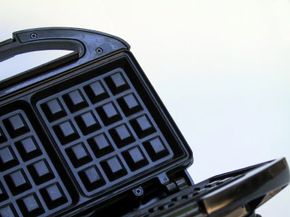PTFE and Cookware
Polytetrafluoroethylene (PTFE) has a unique slickness and inactivity with other chemicals that make it very useful in many applications -- it's a component in space suits, and it insulates high-voltage wires [source: DuPont]. Yet these characteristics also pose challenges when it comes to creating nonstick cookware. The nonstick coating must somehow stick to the surface of the pan.
Advertisement
There are many variations of the process to meld the nonstick coating onto the cookware's metal surface. Basically, they all start with the metal base, or substrate, which is created in the shape of the desired cookware. Most nonstick cookware is made of aluminum, but other metals, such as stainless steel, are also used.
The next part of the process deals with applying the nonstick coating to the pan substrate. According to DuPont technology manager William Raiford, there are two ways to overcome the nonstick problem -- mechanically and chemically.
Let's go back to the example of the dance. The chaperones keep the female students from interacting with the male students. To distract the chaperone, a male student might enlist a friend to create a disturbance on the other side of the room, causing all the chaperones to move in that direction. Another tactic might be to build some common ground among the chaperones and students by playing some music from the chaperones' era and getting everyone onto the dance floor together. Either way, the male dancers have a chance to dance with the females.
When making nonstick cookware, the manufacturing version of the male students' disturbance starts with roughening the surface of the substrate. This makes it easier for PTFE's fluorine molecules to stick to the surface. Some methods include roughing the surface with molten metal or chemicals [source: Wolke, Funderburg].
The common ground is a primer or base coat, which has a special formulation that allows it to adhere to both the metal substrate and several nonstick coating layers. The number of PTFE-based coatings, which are either sprayed or rolled onto the surface, depends on the type of pan [source: Cookware Manufacturers Association].
According to Raiford, this process can include heating between each layer, or the layers can be put on top of each other while they are still wet. The final step is sintering. "This is a high temperature bake usually at around 800 degrees Fahrenheit for about three to five minutes," Raiford says -- that's about 427 degrees Celsius. "This dries and cures the polymer and also helps to lock it to the metal."
This coating keeps everything from eggs to meatloaf from sticking to your pans -- but you can't scrub away at it like you can with some cookware. Next, we'll look at how to keep the nonstick finish on your pans pristine.
